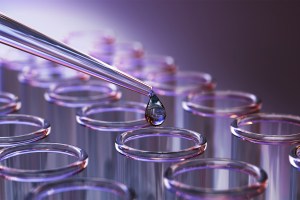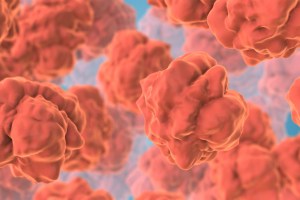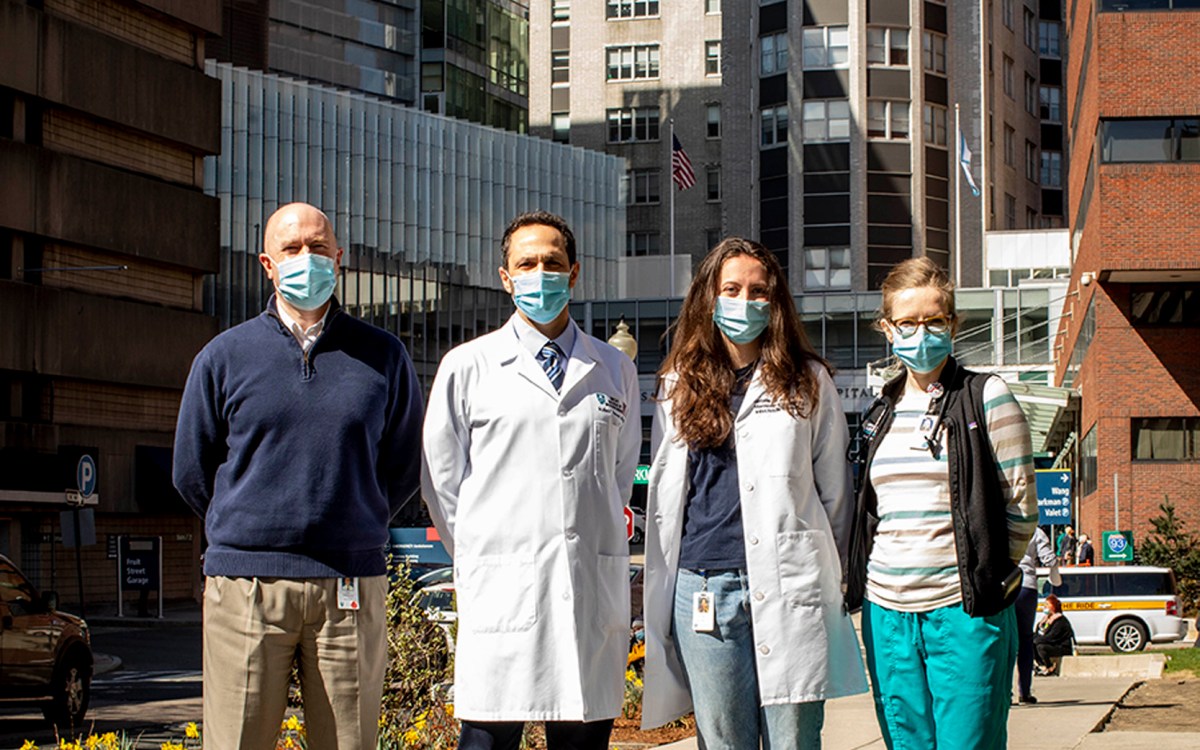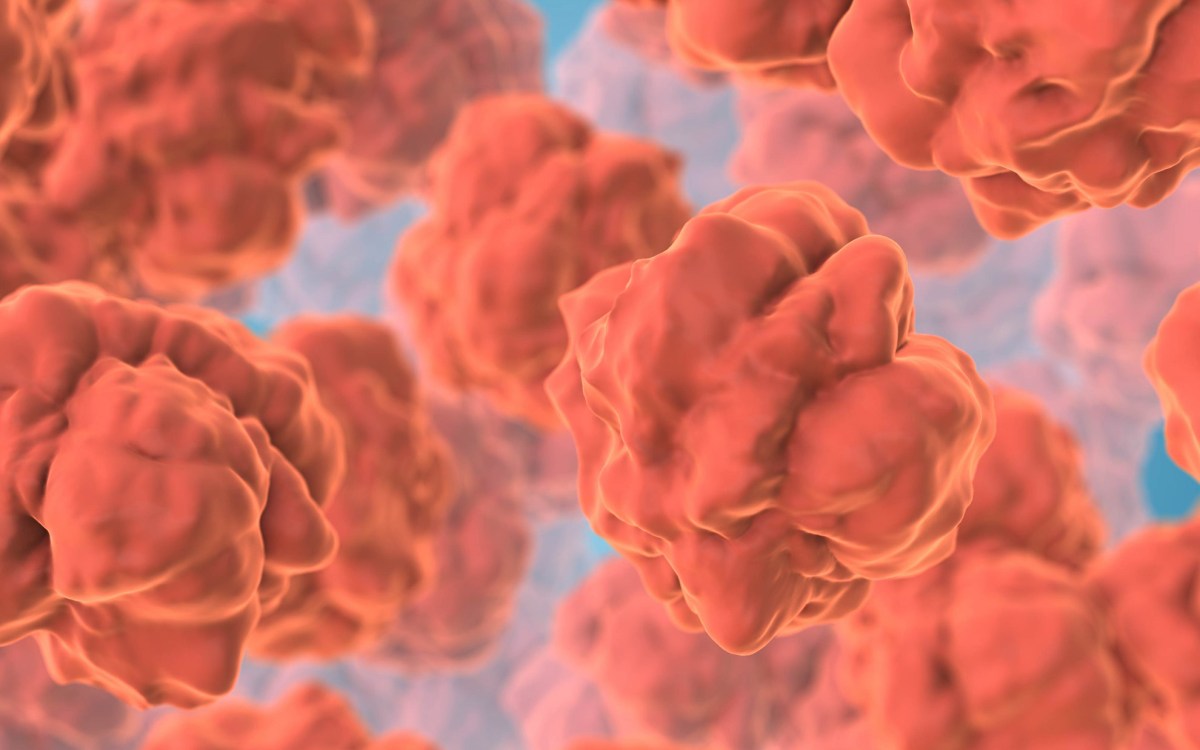‘There’s no treatment if you don’t know what you’re treating’
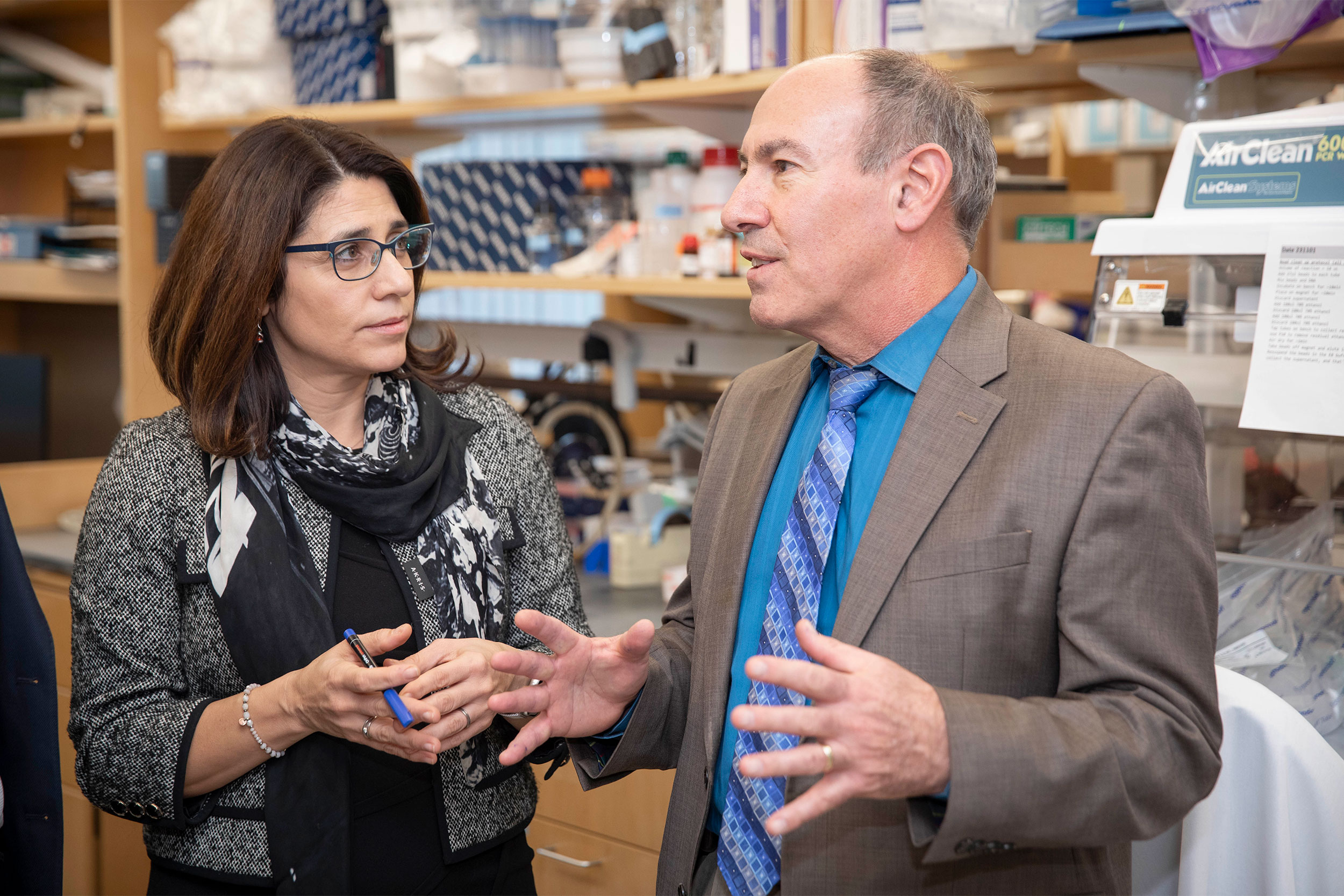
Patricia Musolino, an assistant professor of neurology at Harvard Medical School, and David Sweetser, principal investigator of the Undiagnosed Diseases Network at MGH, traced a baffling smooth-muscle disorder that had affected a teen’s body since birth.
Kris Snibbe/Harvard Staff Photographer
Network of medical detectives solves genomic mystery of boy plagued by series of life-threatening, seemingly disparate ills
It was the day after 9-year-old Rithvik’s surgery that the trouble started.
His mother, Lakshmi Chekuri, couldn’t rouse him when she arrived at his hospital room the next morning. The boy remained sluggish and unresponsive when a neurologist examined him. An MRI showed Rithvik had had a stroke — a malady most commonly associated with older adults. The attack caused significant damage, interrupting the blood supply that brought oxygen to about a sixth of his brain.
“He was nearly paralyzed for a few days, was not able to talk, not able to move his whole body,” Lakshmi said recently. “Slowly, things started coming back. The left side of his body was affected more than the other side. He still has some weakness from it.”
While the MRI told them what happened that day in 2014, it didn’t explain what had been going on over the years before. It would be another nine years before doctors would be able to look at the constellation of Rithvik’s seemingly disparate problems and sleuth out a diagnosis focused on a tiny genetic change. The family’s frightening and frustrating saga provides a glimpse into the promise of genomic medicine.
When Rithvik was born he was diagnosed with “prune belly syndrome,” a disorder affecting the urinary tract and abdominal muscles, which aren’t fully developed or are missing entirely. The tubes that connect the kidneys to the bladder, called ureters, are poorly formed, as is the bladder, rendering it inefficient at expelling urine from the body. The bladder expands as fluid accumulates and can even backflow into the kidneys.
Rithvik had other problems over the years — including an earlier stroke in 2010, during an endoscopy procedure. It was relatively minor, and once he’d recovered Lakshmi assumed it was a one-time thing, related to the prune belly syndrome.
But the cause of the prune belly syndrome had never been identified, and as Rithvik worked his way through the healthcare system, both his family and physicians became frustrated by their inability to understand the root cause of his health problems.
As their suspicions grew stronger, Rithvik’s doctors began to understand they were seeing something so rare that it appeared new.
In the meantime, the procedures added up. His longest surgery lasted 15 hours as doctors removed his ureter and replaced it with one fashioned from a piece of small intestine. His colon malfunctioned, and he had colon surgery during which doctors inserted an ileostomy bag. He needed spinal fusion because, without the support of abdominal muscles, he developed scoliosis. He even had knee and ankle surgery.
“I lost count a long time ago,” Lakshmi said of Rithvik’s surgeries. “I would say close to 20 — or more than that. I stopped counting.”
The symptoms defied a single diagnosis, affecting different parts of the body in different ways. He was seen by doctors at five hospitals, but over the years a pattern emerged. The ailments all affected parts of his body — intestine, bladder, blood vessels — made of a particular type of tissue: smooth muscle.
While skeletal muscle gives us strength and drives movement, smooth muscle plays a key role in autonomous functions we don’t control but are essential for life. The tissue makes up the walls of the esophagus and intestines, pushing food through the digestive process. It gives the walls of blood vessels structure and ensures blood is pushed through the body at each heartbeat. Smooth muscle in the eye opens the iris in the dark and narrows it in daylight. It lines the body’s hollow organs — stomach, bladder, lungs, rectum, and uterus — and also is found in the respiratory, urinary, and reproductive systems.
As their suspicions grew stronger, Rithvik’s doctors began to understand they were seeing something so rare that it appeared new. Even though it likely has been afflicting humans for millennia, the malady had eluded diagnosis for most of that time due to the diverse and puzzling symptoms and a lack of knowledge about the human genome.
Connecting diffuse dots into a clear picture
In 2012, Patricia Musolino, then a neurocritical care fellow at Massachusetts General Hospital, was viewing images of a 2-year-old patient with injury to her brain’s white matter, made up of bundles of nerve fibers that connect nerve cells. It was clear something unusual was going on. The child’s carotid arteries, which transport blood from the trunk to the head, were malformed and too large. But when they branched into cerebral arteries — which carry blood to the brain — they were too small, and likely the cause of the girl’s white-matter damage.
“I said, ‘There is something here that I have never seen before,’” Musolino, an assistant professor of neurology at Harvard Medical School, said recently. “So we studied the patient a bit more.”
The toddler had multiple health problems. Her bladder didn’t work. She’d had respiratory problems, seizures, and a defect in the blood vessels coming from the heart that required surgery in the first weeks after birth.
“She had a very difficult start,” Musolino said. “She had all kinds of symptoms.”
The referring team ordered a whole-exome sequence. The procedure, relatively new at the time, analyzes a critical part of the genetic code called the exome, which includes the 23,500 protein-coding genes in the human body. This protein-coding region accounts for about 2 percent of the human genome. Proteins are vital molecules that perform many functions in the body and include hormones, enzymes, and molecules that provide structure, including in the muscles.
The sequencing showed a mutation in a gene called ACTA2, which encodes a protein called alpha smooth muscle actin isotype 2. The protein forms an important part of the structure within smooth muscles, which control vital automous functions.
Over the next dozen years or so, Musolino’s group would become one of a handful in the world that studied, characterized, and treated patients with that ACTA2 mutation, which causes a condition with the tongue-tying name of multisystemic smooth muscle dysfunction syndrome, or MSMDS.
Over that time, their progress — and that of other groups studying the condition — would lead to measures to prevent strokes and give hope to parents struggling to understand what was happening to their children.
“Honestly, it gets exhausting,” said Warren Anderson, whose son, Raistlin, became the 24th MSMDS case when he was diagnosed by doctors in Oklahoma. “I can say that when we first began this, it was extremely lonely. There were so many questions that were just impossible to find answers to, and I know that drives us to connect to people.”
Anderson and his wife, Lydia, were among a small group of parents who organized the nonprofit ACTA2 Alliance in 2019 to support research into the condition and to share information with other families. Raistlin’s case was diagnosed only after Lydia — a former cancer researcher in Lexington, Massachusetts — searched the scientific literature and then insisted that physicians conduct genetic tests.
But even after the diagnosis, Raistlin’s array of symptoms led their physicians to conclude he needed care they couldn’t provide. The family moved back to Massachusetts to be near specialists familiar with MSMDS.
“The difference is when we ask questions here, there is an answer. There, there were no answers at all,” Anderson said. “There were lots of shrugs, a lot of conjecture, lots of brainstorming, but no real concrete stuff. That’s through no fault of their own. There’s just very little knowledge of MSMDS.”
A national network for medical mysteries
In Rithvik’s case, his doctors at Boston Children’s Hospital — the fifth at which he sought care — suspected MSMDS and ordered whole-exome sequencing. But the test showed that Rithvik’s ACTA2 gene was normal. That was when doctors suggested his family contact the Undiagnosed Diseases Network.
The network, sponsored by the National Institutes of Health, involves 11 top research institutions nationwide and focuses the attention of top specialists onto the most puzzling cases.
David Sweetser, principal investigator of the Undiagnosed Diseases Network at Massachusetts General Hospital and assistant professor of pediatrics at Harvard Medical School, said several local institutions are part of the network, including MGH, Brigham and Women’s Hospital, Boston Children’s Hospital, and Harvard Medical School, which hosts one of the network’s Data Management Coordinating Centers.
“These, by and large, have to be patients that have already been worked up and availed themselves of all of the latest genetic opportunities that would be available to them at their previous institutions, and remain undiagnosed,” Sweetser said.
Once accepted, researchers and physicians take a “really deep dive” into the patient’s past medical history. They conduct a detailed review of all records and test results, including genetic testing. In about 15 percent to 20 percent of cases, Sweetser said, they are able to make a diagnosis based just on the records review, finding something that was overlooked by the patient’s physicians.
“Knowing that mutations in microRNAs can cause genetic syndromes opens a whole new area of investigation that has been overlooked until now.”
David Sweetser, principal investigator of the Undiagnosed Diseases Network
For the other cases, the records review leads to further investigation that employs the knowledge and resources of specialists at the participating institutions. When necessary, they conduct their own DNA or other tests in search of a cause.
“We tap into the huge set of expertise that we have at Mass General Hospital, which includes many of the world’s experts on some very esoteric things,” Sweetser said. “That’s how we made the connection with Dr. Musolino, who, just by coincidence, happens to be one of the world’s experts in multisystemic smooth muscle dysfunction.”
‘This is that disease’
When Musolino reviewed Rithvik’s records, she immediately recognized the hallmarks of MSMDS. Smooth muscles line the intestinal tract, and Rithvik’s had been dysfunctional enough that he’d been fed intravenously since age 2. Smooth muscles line the bladder and his had been rebuilt. Smooth muscles line the arteries carrying blood throughout the body, including the brain, and problems there played a role in his strokes and injury to his brain’s white matter.
But the results of Rithvik’s genetic tests made her pause, as it had the physicians at Children’s. He didn’t have the MSMDS mutation in his ACTA2 gene, but the suite of symptoms were too similar to MSMDS for Musolino to move on to another diagnosis.
“I went back to David Sweetser and his team and said, ‘Find anything that regulates these genes,’” Musolino said. “‘It has to be something that is regulating the smooth-muscle cytoskeletal genes, because he has that disease.’”
Sweetser’s team first re-examined the ACTA2 gene and nearby regions of Rithvik’s DNA for defects they might have missed. That turned up nothing, so they ordered a whole-genome sequence — more involved and expensive than exome sequencing — and began to look for mutations outside of the exome that might somehow affect the ACTA2 gene.
“Everything came up negative until we looked with a magnifying glass at specific microRNAs that control smooth-muscle actin … and [genetic counselor] Lauren Briere said, ‘Hey, I think I found something.’”
Patricia Musolino, Harvard Medical School
The exome’s protein-coding genes are critical to the body’s functioning, but only make up about 2 percent of the genes in the body. The purpose of much of the remaining 98 percent of the genome is unknown. But what is known, Sweetser said, is that a significant portion of those genes encode not proteins but RNA and that some of these RNA act as regulators, switching genes on and off at critical times.
It took some searching, but Lauren Briere, a genetic counselor and clinical coordinator for the MGH Undiagnosed Diseases Network, noticed a minor change in the gene for a microRNA called MIR145, which was known to be involved in smooth-muscle formation.
“Everything came up negative until we looked with a magnifying glass at specific microRNAs that control smooth-muscle actin,” Musolino said. “And Lauren Briere said, ‘Hey, I think I found something.’”
Finding a single nucleotide change in MIR145 was just the start, however. It took the help of Mark Lindsay and Christian Lino Cardenas, experts in smooth-muscle and vascular biology, as well as months of working with cell cultures and lab mice to confirm that the mutated MIR145 interferes with ACTA2 and creates the same suite of MSMDS symptoms as a mutation in ACTA2 itself.
“Knowing that mutations in microRNAs can cause genetic syndromes opens a whole new area of investigation that has been overlooked until now,” Sweetser said.
No treatment without diagnosis
More like this
The diagnosis, made earlier this year, put a name to Rithvik’s condition and gave his family, for the first time, an understanding of what had been happening to him since birth.
In addition, with a specific mutation to screen for, his parents and sister — a high school freshman — got tested and had no trace of the mutated gene. That meant that, though the condition stems from a mutated gene, it wasn’t inherited. Sweetser said that’s possible because every time sperm and egg join and begin to grow, a small number of random mutations occur. Usually, these mutations are harmless, but, as in Rithvik’s case, sometimes they affect the functioning of important genes.
The diagnosis has brought a measure of peace to his family and allowed Rithvik’s physicians to fine-tune his treatment, stabilizing him and reducing the number of acute episodes he experiences. Today, Rithvik is a high school senior and hopes to graduate this year. But what the diagnosis hasn’t brought — at least not yet — is a cure.
Significant hurdles remain, Musolino said, but work toward understanding, treating, and correcting the genetic flaws that lead to MSMDS has made steady progress. Researchers have moved from cell cultures to mouse models, and recently were able to cure the condition in a line of mice created with the ACTA2 mutation that causes the disease. Untreated, these mice die at around 8 weeks of age, but using CRISPR gene editing technology, Musolino’s team has been able to correct the flaw in ACTA2 and restore smooth-muscle cell and vascular function. Mice treated at 3 days old are still alive 8 or 9 months later, approaching middle age. Musolino said she’s hoping to begin clinical trials of the procedure in humans by 2025.
While that is encouraging for those with the ACTA2 mutation, Rithvik’s is the only case known in which MSMDS is caused by a mutation in MIR145. That means the ACTA2 gene therapy won’t work on him. It also makes devising an alternate cure, for a single patient, very expensive.
Still, Musolino said that other options exist. MicroRNA can be manufactured, meaning that Rithvik could potentially be treated with normal MIR145 microRNA. That should restore some functionality to his ACTA2 gene and perhaps ease some symptoms if researchers can selectively target his smooth-muscle cells.
“There’s no treatment if you don’t know what you’re treating, and we absolutely know what we’re treating,” Musolino said. “We have proven in the dish we can make it better with microRNA therapeutics and now we’re investigating how to do it safely in him.”

